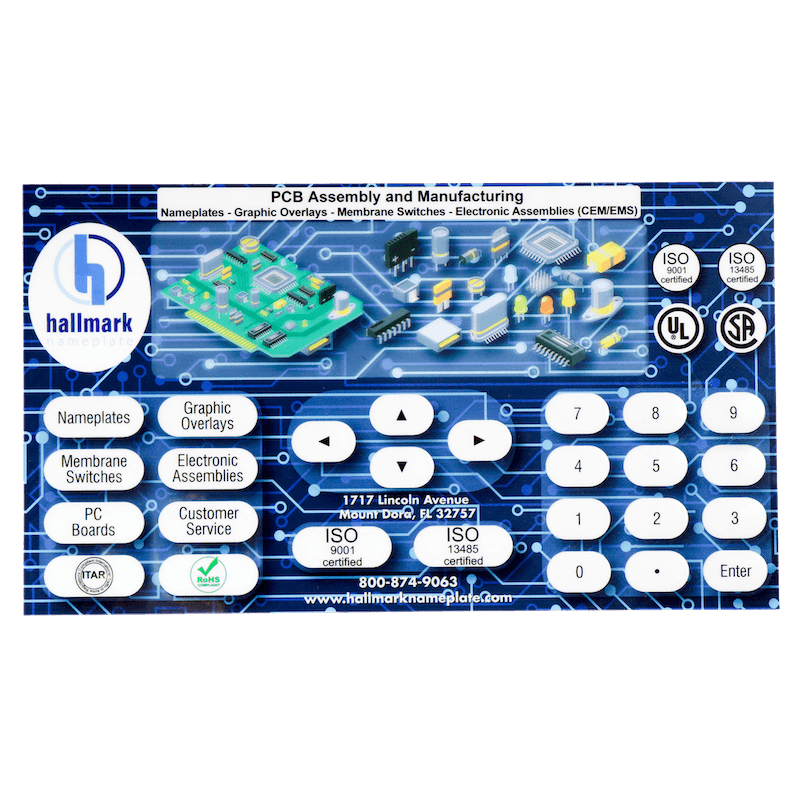Innovative Membrane Switch Solutions for Customized Control Panels
Innovative Membrane Switch Solutions for Customized Control Panels
Blog Article
Comprehending Membrane Switches Over: The Secret to Resilient and Reliable Controls

What Are Membrane Switches?
Membrane buttons are an innovative remedy in the world of interface technology, integrating performance and layout perfectly. These devices work as an interface between individuals and electronic systems, integrating a number of parts right into a portable style. Typically constructed from versatile, slim layers of products, membrane layer buttons are designed to reply to touch, allowing individuals to interact with equipment and digital devices effectively.
The main aspects of a membrane button include a published circuit layer, graphic overlay, and a spacer layer that prevents unintentional activation. The visuals overlay can be personalized to show brand name identity or individual preferences, improving visual appeals while making sure functionality. Membrane buttons are generally used in numerous applications, consisting of medical devices, customer electronics, and industrial devices, owing to their sturdiness and resistance to ecological elements such as wetness and dust.
Among the key benefits of membrane layer switches is their capacity to hold up against wear and tear, making them optimal for high-traffic atmospheres. In addition, they are light-weight and require very little area, permitting ingenious styles in item advancement. In general, membrane changes represent a efficient and useful selection for modern digital interfaces, weding modern technology with user-centric design principles.
Exactly How Membrane Changes Work
The operation of membrane switches over hinges on a basic yet efficient device that translates individual input into electronic signals. When a customer presses the button, the top layer warps, allowing a conductive component in the circuit layer to make call with a matching conductive pad on the underside of the visuals overlay.
The design of membrane layer buttons can differ, but they typically integrate domes or responsive components to supply feedback to the individual, enhancing the general experience - membrane switch. The products used in membrane layer buttons, such as polyester or polycarbonate, contribute to their longevity and resistance to ecological variables, consisting of moisture and dirt. Additionally, the printed circuits are normally enveloped, which shields them from wear and tear with time.
Benefits of Membrane Layer Switches

Furthermore, membrane layer buttons are understood for their resilience. Built from durable materials, they are immune to dust, wetness, and physical wear, which significantly prolongs their lifespan contrasted to conventional mechanical buttons. This resilience makes them Learn More specifically ideal for high-traffic settings and applications needing longevity.
Another significant benefit is the convenience of cleansing and upkeep. The smooth surface of membrane changes minimizes dust accumulation and is often invulnerable to spills, making them ideal for settings that need constant sanitization.
In addition, membrane buttons provide a structured account, causing a thinner design that can be integrated into different gadgets without adding bulk. This function not just boosts the aesthetic charm however also adds to an extra ergonomic item design.
Applications of Membrane Layer Switches
Functional and easy to use, membrane switches find applications across a wide variety of markets, including clinical tools, customer electronics, and commercial tools. In the medical field, these switches are important to tools such as analysis equipment, person tracking systems, and infusion pumps, where integrity and ease of cleaning are vital. Their ability to stand up to extreme environments and maintain capability makes them perfect for such applications.

In customer electronic devices, membrane switches are used in items like microwaves, cleaning devices, and push-button controls Check This Out - membrane switch. Their streamlined layout enables intuitive customer interfaces, boosting the total customer experience while giving sturdiness and resistance to damage
Commercial equipment additionally benefits from membrane layer buttons, particularly in control panels for equipment and automation systems. These buttons use defense against dust and dampness, making sure constant efficiency in difficult environments. Moreover, their adjustable features permit makers to customize them to certain functional demands, boosting efficiency and functionality.
Picking the Right Membrane Layer Switch
When selecting a membrane layer switch, it is vital to consider numerous variables that influence performance and suitability for specific applications. The key factors to consider consist of ecological problems, tactile feedback, toughness, and design specs.
First, analyze the operating environment; switches subjected to wetness, chemicals, or severe temperature levels call for certain products to make certain long life and performance. Next, review the need for tactile responses. Relying on customer interaction, some applications may take advantage of a tactile response to validate activation, while others may choose a non-tactile design for aesthetic factors.
Durability is one more important factor; membrane layer switches must be designed to stand up to constant usage, influences, and abrasion. Guarantee the picked switch can endure the anticipated lifecycle, especially in high-usage situations.

Conclusion
In conclusion, membrane layer switches over serve as necessary elements in the layout of trusted and durable control systems throughout various industries. The versatility of membrane layer switches over enables for tailored services that fulfill details functional demands, enhancing their importance in contemporary technology.
Membrane layer switches over represent an important facet of modern interface style, mixing capability with resilience in different applications.Membrane layer switches are an advanced remedy in the realm of individual interface technology, combining capability and style perfectly. Usually constructed from versatile, thin layers of products, membrane buttons are developed visite site to react to touch, enabling individuals to communicate with machinery and digital devices successfully.
The design of membrane buttons can vary, however they commonly integrate domes or responsive components to supply responses to the user, enhancing the overall experience.In conclusion, membrane layer changes serve as important components in the style of long lasting and reliable control systems across different markets.
Report this page